#gion district
Text
Travel is good, tourism isn't

I said in the blog yesterday, that I think travel is good, but tourism isn't. So, let me explain this. And I will put this here first: I am going to explain it on the example of Japan, because I know the most about what is happening there in terms of travel and tourism - and what issues arise from it.
See, I do think travelling to foreign places (whatever that means for you) is a good thing. Experiencing other cultures and interacting people who due to their culture have a very different outlook on life and the world is a good thing. Not only to move away from a certain worldview (which for white people tends to be an eurocentric one, and for Americans an US-centric one), it also fosters empathy to other people.
And I think of this dramatic thing especially when it comes to Americans travelling, who due to their lacking education system often do know jack shit about the rest of the world.
However: I do both think that the thing we right now call tourism does not really help, but actually does hinder this - and is harmful in many other ways.
Right now, foreign tourists are no longer allowed in Gion, the Geisha quarter of Kyoto. The reason for it is, that too many of them were fucking disrespectful. Some made photos of the Geisha without asking, some even touched the kimono and the hair of the Geisha. Some even got angry and started arguing, when people told them to not do this.
Especially when it comes to Kyoto I can think of a variet of other examples. People have carved their names into temples. People touched things that are not supposed to be touched (like idols). People otherwise behaved inappropriately, for example towards kannushi and mikos. Folks have bathed their feet in pools meant for ritual cleansing. There are a lot of examples of this.
And I think part of this goes back to two things. For one again eurocentrism and the way, that a lot of especially white folks to not perceive other cultures as real. But also, and maybe more importantly, the mindset that: "I have paid $1500 for this trip and I get to very well do what I want." The different culture in this mindset gets treated like a themepark, not as a place filled with real people, rather than performers there to enhance the tourist's experience.
Meanwhile the tourists generally are not really interested to interact with the other culture further than that. Which is also, why they tend to flock to the same few places, to all go make their own photo of the same place that a million people have photographed before - as compared to going exploring in a foreign place.
And in some cases - like Kyoto - this also leads to the fact that the local people often get pushed out of the places they actually live in.
A lot of people will often say: "Yeah, but it is great for their economy." Which... leaving my capitalism-hating-ideation aside for a moment... Well, actually it is not good and COVID showed us. Because it makes the economy totally depedent on tourism. In places that are heavily dependent on tourism, the sudden complete anihilation of tourism with the pandemic pushed those places further into a crisis than anywhere else. Heck, keeping it with Kyoto: Given a lot of folks had jobs related to the tourism industry and there were in fact not many other jobs, a lot of people found themselves forced to move away from Kyoto during the pandemic.
So while the entire "but economy" thing will seem true on a short term, it actually is not on the long term.
And that is without going into the environmental impact that comes from a lot of people flocking to certain places. This is shown especially in areas, where folks go for "nature", destroying nature while they do so. Because nature just cannot handle thousands upon thousands of people travelling through.
So, what do I mean with "travel, instead of tourism"? Well, frankly: Yes, you still go to other places. But - to keep with Japan - instead of going to Kyoto you might go to Morigushi or Beppo, and instead of touring from one temple and shrine to the next, you will just interact with the places and explore them. To actually experience them, rather than some preconscieved notion of what it is supposed to be. And you interact with the people.
And you learn. Because we all just need to learn about different people, different cultures and different places. Rather than just consuming them.
#travel#tourism#anti tourism#anti capitalism#fuck capitalism#eurocentrism#solarpunk#lunarpunk#philosophy#japan#kyoto#gion district
88 notes
·
View notes
Text
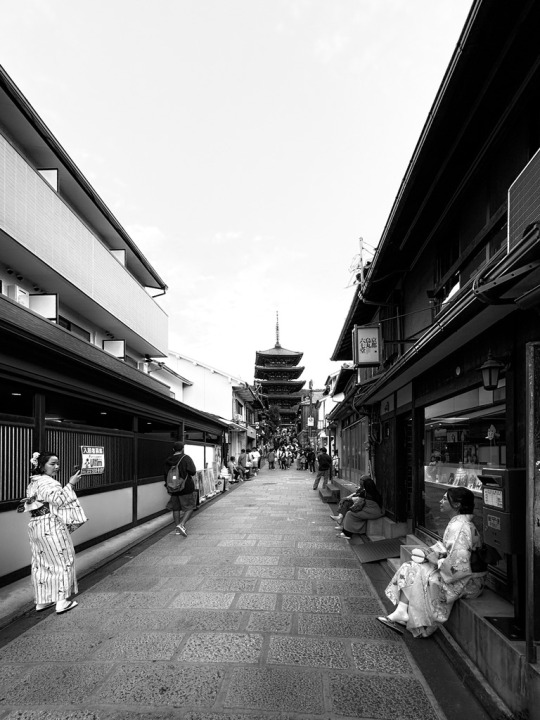
© Paolo Dala
Ancient X Modern
Japan is a country where ancient and the modern are inextricably intertwined.
Steve McCurry
#Steve McCurry#People#Traditional#Modern#Kimono#Temple#Street#City#Black and White#Portrait#Urban#Gion District#Kyoto#Japan
16 notes
·
View notes
Photo

Known as one of the historical hubs of Japan, Kyoto has a notable number of well-preserved neighborhoods, majestic temples and all manner of photo-worthy landscapes.
(via 15 of the best free things to do in Kyoto - Lonely Planet)
#kyoto#kyoto japan#lonely planet#visit japan#travel#fushimi inari taisha#Nishiki Market#geiko#gion district#hanami#Kamo River#Yasaka Shrine#Arashiyama
6 notes
·
View notes
Text

Hanamikoji Street - Yamamoto Tomokatsu (1953)
Hanamikoji street at Gion district in Kyoto. Yamamoto Tomokatsu was a Nihon-ga painter born in Kyoto. He received Kyoto Cultural Awards and was a jury member of the prestigious Nitten art exhibition.
source
#japanese art#ukiyo e#woodblock print#kyoto#gion district#maiko#geiko#geisha#japanese culture#japan art
20 notes
·
View notes
Text
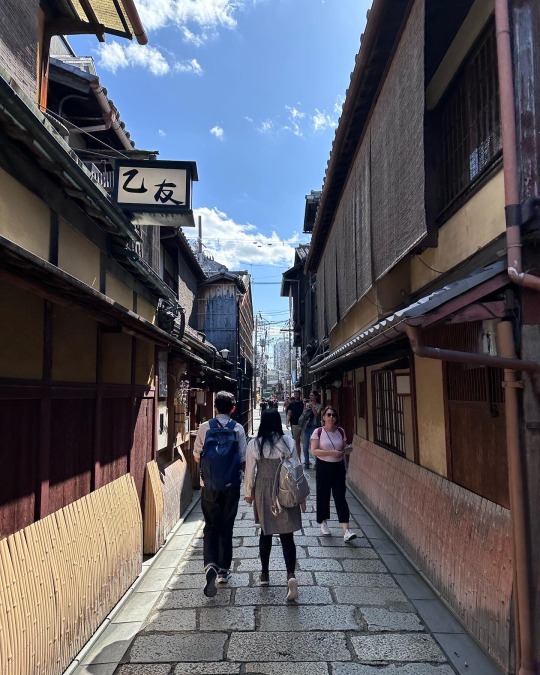

My Japan Trip : Gion
21 notes
·
View notes
Text
im generally not a selfie-taker cuz i dont like being In Photos / Being Perceived, but especially when it comes to holiday photos i personally hate taking photos of myself in front of landmarks. i want the location to speak for itself, i dont need to be in the photo to prove i actually visited!
but also tbh i find it a little annoying when people spend like 5 minutes trying to get that Perfect Photo right in front of a landmark and they're doing all sorts of poses and stuff. like you do you but also please be considerate of other ppl also wanting photos......
#rai travelog#especially at the Thousand Torii Gates where you have queues of people trying to walk through the gates#and other people just stop right in the middle to take selfies??#also the amount of people ive seen pulling cherry blossom tree branches to get photos of petal falling around them#or wanting photos framing their faces with cherry blossoms#hell i saw one tourist using a cherry blossom branch as a walking stick and i was just god i hope you picked that off the ground#no wonder the Gion district is closing its doors to foreign tourists soon. im going tomorrow but im not taking photos lmao
2 notes
·
View notes
Text
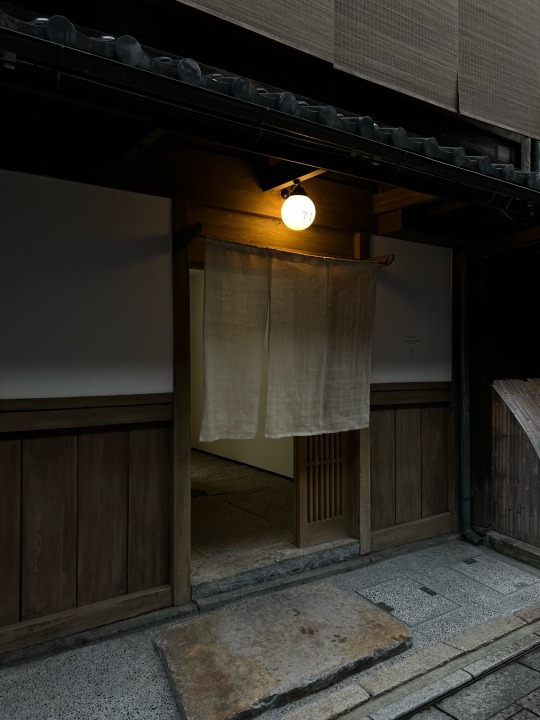


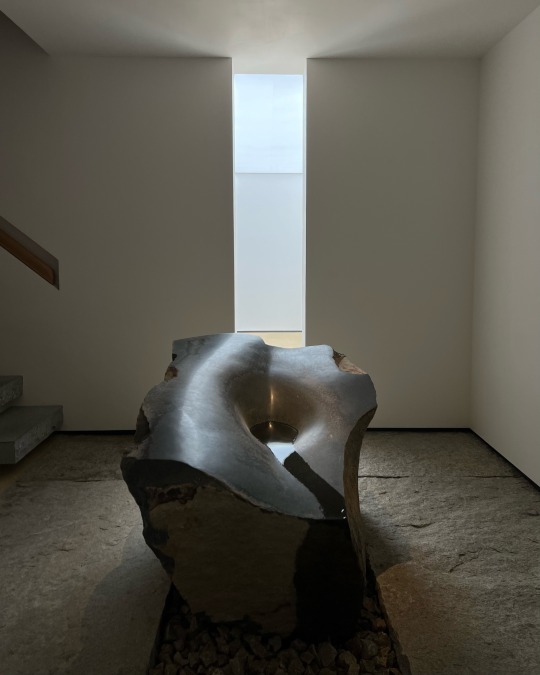
T.T. The store and tea room of the late Taiga Takahashi in Kyoto’s historical Gion district
2K notes
·
View notes
Text

In the heart of Kyoto's Gion district, a scene unfolds like poetry in motion. I stumbled upon a captivating sight that's hard to forget: a beautiful woman in a crimson kimono stands out, navigating the streets with a grace that echoes through the ages.
Kyoto [ 京都], Gion [祇園]
Japan, November 2023
Ph. Aleksandra
Instagram: tanzdreamer
#京都#祇園#kyoto#gion#red#japan#日本#kimono#yukata#japanese#着物#浴衣#photographers on tumblr#my photography#photography#traditional wear#japanese culture#mine
177 notes
·
View notes
Text


November 14th, 2023: Double congratulations are in order for Kyoto's newest celebrants! Mameyui (豆結) of Ninben (亻) in Gion Kobu is celebrating her erikae while Fumiyui (富美唯) of Toshikimi (利きみ) in Miyagawa Cho is celebrating her misedashi! Mameyui's is the third erikae for her district this year so far while Fumiyui's misedashi is her district's fourth misedashi of the year. Mameyui's outfit features a beautiful design of a stream among purple hills with flowers and fans while Fumiyui's outfit features auspicious plants, folding screens, and haze ^^
おめでとうさんどす豆結さんと富美唯ちゃん ^o^!
Images are courtesy of Mameryo and Polyphenol Vinest.
#maiko#geiko#geisha#kyoto#news#舞妓#芸妓#芸者#京都#erikae#misedashi#gion kobu#miyagawa cho#ninben#mameyui#toshikimi#fumiyui#襟替え#衿替え#ゑりかへ#祇園甲部#亻#豆結#宮川町#利きみ#富美唯
111 notes
·
View notes
Text

The geisha Momotaro worked in the Gion Kobu district of Kyoto. 1920s, Japan
56 notes
·
View notes
Note
Was hijikata married? Or he had lover before?
Hijikata was never married, but he had many lovers.
Even in his earlier years in Edo, he frequented Yoshiwara and had a woman there (source). He wrote the poem:
The way of love
If you know it, you are lost
If you know it not, you will not get lost
(And then crossed it out, probably out of embarrassment) 😅
When he was 17, he got into a relationship with a maid at the kimono shop where he worked. She became pregnant, but he broke up with her after giving her money. (source)
He did have a fiancee named Koto who was the daughter of a shamisen shop owner, but he left for Kyoto before they could marry. He sent her a present and visited her whenever he was in Hino. She waited for him to return home, but he broke up with her when he went back for a visit in 1867 (He kept her waiting for 4 years...) (source)
Here's more info about it: (source)
Tamejiro, Toshizo’s eldest brother, enjoyed playing the shamisen, so he went to a shamisen shop owned by a distant relative of Sato Hikogoro. Okoto was a beauty with a good reputation in the neighborhood, and Toshizo liked her so much that he and his relatives discussed the possibility of marriage. However, Toshizo said, “I want to become a samurai and make a name for myself. Therefore, I cannot have a family here and now. I want you to let me be free for a little while longer”. Perhaps still harboring lingering feelings for the beautiful Okoto, Toshizo left for Kyoto with the meaningful poem, "The way of love, if you know it, you are lost; if you know it not, you will not be lost”. It’s said that Okoto could not give up on Toshizo and remained unmarried for the rest of her life. As an aside, it’s said that Hijikata went to see Okoto when he returned to his hometown in Keio 4 (1867). It’s not known what they talked about.
While in Kyoto, he was very popular with women and he had a colorful life with the oiran and geiko. I remember reading that he had 6 mistresses at the same time, but I can't find the source. Another source says that he didn't take any of them as mistresses.
He once sent home a pile love letters that he had received, along with a letter where he lists many women from the red light districts, probably attempting to attract more recruits. He wrote:
By the way, although we strive to serve our country faithfully and patriotically, I am attracted to women in ways I cannot describe with a brush. For example: in Kyoto, in Shimabara, there’s Hanagimi-tayu and Ichino-tenjin; in Gion, there are about three so-called geiko; in Kitano, there are the maiko Kimigiku and Koraku; in Osaka, in the Shinmachi district, there’s Wakazuru-tayu and two or three others; and in Kitano, in the Shinchi district, the number is so large that I’ll run out of ink if I listed them all. Imagine that!
Women make me forget to do my best for the country.
Toshizo has gone astray!
Here's more info about it: (source):
During his time in the Kyoto Shinsengumi, Toshizo was a good-looking man, so he also had many love affairs and proudly sent home love letters he received from many prostitutes to Kojima Shikanosuke. First, he wrote about Hanagimi-tayu (花君) and Ichino-tenjin (一元) in Shimabara, three geiko in Gion, Kimigiku (君菊) and Koraku (小楽) in Kitano, and Wakazuru-tayu (若鶴) and three others in Osaka Shinmachi. He is said to have had affairs with 12 women during his time in Kyoto. However, he did not take them as his mistresses like Kondo and the other executives, but rather parted with them cleanly. However, Sato Toshinobu, Toshizo’s nephew, visited Kyoto in 1887 and found out that Kimigiku, who lived in the Kamishichiken district outside the east gate of Kitano Tenjin, gave birth to Toshizo’s baby girl, but the baby died prematurely, and Kimigiku married someone else but eventually died.
Kondo once wrote in a letter that the Vice-commander was bragging about his numerous women. In addition, many of the higher ranking members had more than one home in Kyoto where they kept their lovers. Hijikata was said to have been the worst offender in this regard. (source)
After returning to Edo, he was still very popular with women:
The Shinsengumi spent in Goheishinden just after Kofu. Hijikata spent some of his time fishing in the river there, while still using the name “Naito Hayato”. No one in the area knew that he was actually Hijikata Toshizo of the Shinsengumi, so his reputation was not an influence on what happened next. Before long every girl in the village had gathered on the riverbank to watch the “handsome samurai”. It was agreed by all of them that he was “a nice man”. (source)
It seems that some time after that, he stopped having relationships with women:
By the time Hijikata went to Ezo, he was avoiding women altogether. As far as anyone knows, he had no children. (source)
If you want to read more about the Shinsengumi's love lives, you might be interested in the posts translated from Shinsengumi Koiuta. There are many interesting stories.
46 notes
·
View notes
Text
I finished The Makanai: Cooking for the Maiko House this weekend, and I feel like I’m still laid out flat by what I watched. I’ve been so consumed with QLs lately, that jumping into a wholly different world of filmmaking was a touch of a shock. IT WAS ABSOLUTELY STUNNING, and I have to wholeheartedly RECOMMEND IT as a must-watch for 2023. LONG post!
First off: Koreeda Hirokazu. A MASTER director and screenwriter. His taking on the canon manga, Kiyo in Kyoto, had fans in anticipation for The Makanai to premiere on Netflix. My two favorite films of his are After Life (1998) and Like Father, Like Son (2013). He doesn’t shy away particularly from difficult stories about families and complicated relationships, and tends to cast familiar faces, especially Lily Franky. His latest film, Broker, has been on the awards circuit this season.
A couple of quick definitions and explanations before I move forward. This is a show about what us in the West called “geisha” culture in Kyoto. A maiko is an apprentice geisha, and geiko is the word for geisha in Kyoto’s dialect. A makanai means a person who cooks staff meals, say, at a restaurant or another kind of business where staffers get fed.
Kiyo in Kyoto is about the teenage protagonist, Kiyo, becoming the makanai of a maiko lodging residence in Kyoto, after she follows her best friend, Sumire (later known as Momohana), to Kyoto to apprentice as maiko. Sumire has a natural talent for this work, while Kiyo is a carefree, unburdened soul who isn’t committed to much in her young life. Kiyo is expelled from her maiko apprenticeship, but asks to become the makanai of the lodging house, and is able to stay in Kyoto, and close to Sumire, as Kiyo had promised to remain by Sumire’s side during their journey into apprenticeships. Both Kiyo and Sumire are from the same town in Aomori Prefecture, the northernmost prefecture on Honshu island, just south of Hokkaido. In Aomori, Kiyo lived with her grandmother, a local doting soul, and her grandmother’s kitchen is where Kiyo first found her passion for food and cooking. Finally, Sumire is in love with their mutual friend, Kenta, who is a high school baseball star in Aomori. It’s not clarified directly, but it’s apparent that Sumire’s love is unrequited, and indeed, it’s indirectly indicated that Kenta might be more inclined towards Kiyo. Kenta is shown sitting with Kiyo’s grandmother for many meals, including holiday meals, without explanation as to his own family.
So that’s already A LOT to manage, and still, Koreeda takes on more -- he takes on the unbelievable setting that is Kyoto and the Gion district, as well as flashbacks to winter-strewn Aomori; he takes on rivalries, regrets, sisterhood, and more among the women of geiko and maiko culture; he takes on the breathtaking theme of unrequited and resistant love, and he takes on the theme of complicated -- very complicated -- friendship, leveraging Kiyo as an unburdened foil and mirror to reflect on the complicated natures of the people around her.
First off, if you are at all inclined to be taken away simply by cinematography, you MUST WATCH THIS SHOW. I haven’t watched anything more beautiful in a VERY long time. This brings up for me the wonderful conversation that took place last month regarding the sense of space in QLs; in regards to the sense of space and how ma (that very intricate concept of place, time, and space) is incorporated into doramas -- I haven’t seen a show that does it better than The Makanai at the moment.
The way Koreeda captured seasons. The way he incorporated fashion -- what geikos and maikos wear during performances, on their off-time, during celebrations -- my GOD. The way he used COLOR. The way he used quiet, and sound, to lift up conversations outside in spectacular settings. The way he held shots. SUMPTUOUS. I was totally taken away.
Two shots that moved me: Kiyo in a sento bathhouse, humming to herself. (She’s later teased, without her knowing, by some of the maiko, for being like an old man, scrubbing and humming in the sento.)
Kiyo, Kenta, and Sumire, a flashback to Aomori, Kiyo and Kenta shoveling snow while Sumire built a snowman. And an immediate cut to Sumire watching Kiyo shovel snow in Kyoto. The quietness and the beauty gave me physical chills.
Kiyo as a free soul, moved by her passion for cooking and not much else, is leveraged so beautifully as a means of a young woman being in a place at a particular time, without carrying the emotional burden of existence that many of us place on our shoulders. She’s not the person who asks why something is happening in her life. She’s the one who’s feeding the people who are doing that asking unto themselves, and suffering either because of that inquiry, or suffering simply because of an inability to transcend what they’re going through. Kiyo is clearly a Zen-like foil -- even though she’s treated often as someone “with a screw loose,” as the geiko Momoko says to Sumire in the last episode. But I think Kiyo is far more in touch with the world than anyone else that surrounds her in the show. She’s the human embodiment of ma.
So, speaking of cooking: the reason why I picked up this show is because friends of mine recommended it to me as a cooking dorama, and certainly, a lot of news coverage in the West focuses much on the food of the show. Many of the Western articles, I think, miss many points about the show, and I think it’s in part for a lack of understanding about how food and cooking are so emotionally interwoven in unspoken aspects of Asian cultures. (A lot of commentary I’m reading just focuses on the dishes -- and the dishes are incredibly important, especially in how Kiyo interprets them from her Aomori taste, adjusting seasonings and techniques for the group of maiko she’s serving who hail from across Japan. But the dishes are not the only, or the most important, aspects to this show.)
Kiyo is often asked if she’s okay with being the makanai. She kept her promise to her friend, Sumire, Sumi-chan, to stay by Sumire’s side. Sumire would ideally like to keep Kiyo by her side -- if Kenta likes Kiyo, it’s better to keep Kiyo in Kyoto. But also: Sumire is primed to be the next best maiko and geiko in Gion, as Momoko predicts (Momoko is the star geiko of Gion), and Sumire will need an ally. Kiyo is Sumire’s ally -- and we’re not sure if Sumire has Kiyo’s best interests at hand.
But Kiyo insists that she’s okay, that she wants to be the makanai. Even at 16, she says, this may be the job I was intended to have. Kiyo radiates simplicity in a fantastic, uplifting way. I think Western critics are missing this. Western food media tends to absolutely glorify, many times in horrific and ignorant ways, dishes without the cultural context of the cooking, preparation, or history of those dishes. In other words, Western media erases the stories behind the cooking.
The Makanai is ALL ABOUT THE STORIES BEHIND THE COOKING. Kiyo is a makanai, and to Kiyo, that’s just fine. She doesn’t find it demeaning because she is not demeaned. She even seems surprised when she’s asked by a lodge okkasan if she’s okay with this job.
Food brings comfort, memories. It satisfies hunger, needs. Comfort, memories, hunger, needs -- these are HUGE, huge. Kiyo does that? That’s massive emotional work. She knows exactly what she’s doing.
So, what all does this show have? Absolutely EXQUISITE cinematography, and an unwinding, mature story focused on the journeys of two teenagers, with ambition, rivalry, regret, love (requited, unrequited, unresolved), and beyond unbelievable acting.
It’s an absolute CRIME that I can’t take screenshots (eff you, Netflix), but here’s two. Hashimoto Ai, as Momoko, is on the right of the first shot. Imagine her kimono as brilliant sky blue. The fashion choices and colors in this show were mindblowing. Hashimoto Ai, by the way -- I STAN. What a CONCRETE performance.


The reason why I chose the second shot, of Sumire in her daily lessons, is because the light from the windows reminds me of when I first started to learn how to meditate years and years ago. The Makanai is one of the most meditative shows that I’ve seen in years, and I CANNOT recommend it highly enough. Utterly breathtaking.
#the makanai cooking for the maiko house#mori nana#natsuki deguchi#hashimoto ai#tokiwa takako#hirokazu koreeda#after life#like father like son#broker#netflix#netflix japanese dramas
113 notes
·
View notes
Text

© Paolo Dala
Love Live Photos
It's tough photographing in famous tourist spots because of the large crowds. There are always photobombers in the background. So, what I do in these situations is to compose the shot in a way where they background feels candid. Perfect timing is require to get these kinds of photos... until I bought an iPhone. Haha! I love iPhone's live photos. It's much more easier to get shots like this.
1 note
·
View note
Text
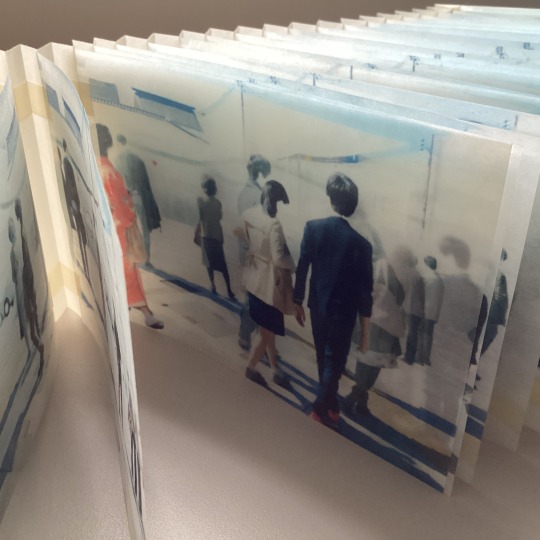
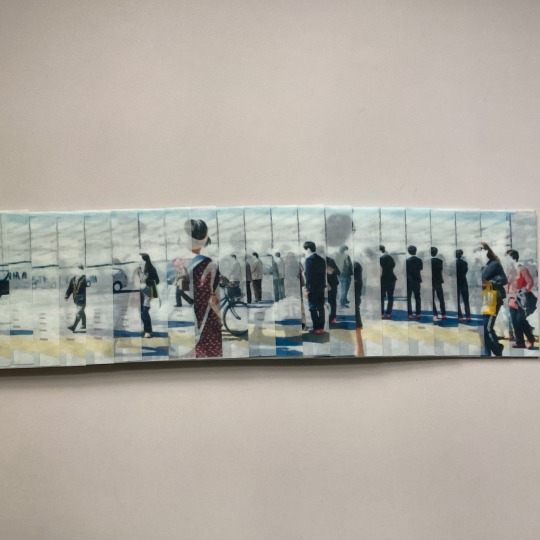


A Kyoto-based artist, Kyoko Matsunaga recorded photographic images of dozens of people and cars passing each other during a single signal cycle at Gion intersection on March 17, 2016. The artist then altered these photographic images by removing some fragments.
Leaves of Mitsumata Japanese paper were inkjet printed with these altered photographic images, letterpress printed with text, and treated with bees wax. Leaves were bound with the artist's original variation on the accordion technique, using paper tabs to attach leaves to a Japanese Harukaze paper cover and concertina structure.
This accordion technique allows readers to stretch the book and see unexpected images as shown in one of the images in this post. It also makes the book more sculptural and flexible to form surprising structures. It is a delight finding different ways to engage with this book.
Gion Matsuri (祇園祭) is taking place in Kyoto during the entire month of July, however, the main festival events take place outside of Gion District.
“Intersection: Gion, Kyoto” captures a slice of daily actions that happen at one intersection.
Intersection : Gion, Kyoto
Matsunaga, Kyoko, 1981- [book artist]
Published: Kyoto, Japan : [Kyoko Matsunaga], 2016.
34 unnumbered leaves : chiefly color illustrations ; 10 x 15 cm
English
HOLLIS number: 99153692019003941
#Gion#ArtistsBooks#ArtistsBook#Kyoto#KyotoMatsunaga#JapaneseArtist#HarvardFineArtsLibrary#Fineartslibrary#Harvard#HarvardLibrary#祇園
26 notes
·
View notes
Text
My Trip to Japan! ⛩️ Part 3
16.12
We had breakfast as soon as service started at 6:30, and then went to take the Shinkansen to Kyoto. The trip lasted just under an hour, and we arrived at 8:30. It was an adventure to get out. It would take us a day and a half to figure out the right way to move around the gigantic Kyoto station without getting trapped like a rat in a maze. We left the suitcases at the hotel, conveniently located just opposite the station, and went straight to Kinkaku-ji, the temple of the Golden Pavillion. The titlepavillion is one of several that make up the temple, though none as spectacular. The gardens were a delight. We had matcha tea at the temple's tea house, with a very tasty sweet bearing the pavillion’s outline and a touch of gold leaf.
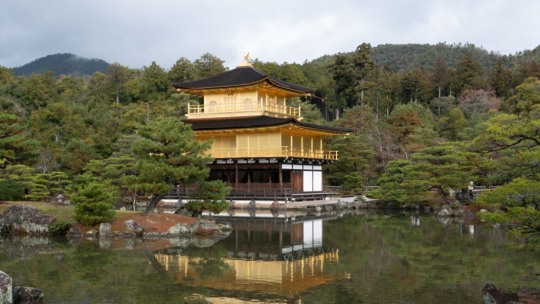
We continued to the next temple, Ryō-An-ji. I liked this one a lot; it has a large stone Zen garden that invites contemplation... until the school outing arrives and misaligns all your chakras. On the way out, I bought a beautiful maiko doll for my niece, and we had a butaman, a very fluffy bread ball filled with pork. Very tasty.
Next on the itinerary was Ninna-ji, with an impressive monumental gate and a cherry blossom promenade that must be a dream during hanami season. Ninna-ji is an extensive complex, with many pavilions and a five-story pagoda. It was already 1 pm so we took a cute vintage train to Arashiyama, where we had some delicious sobaforlunch, looked at shops, and peeked at the Katsura River before attacking the fourth temple of the day, UNESCO World Heritage Site like the other 3: Tenryū-ji. This was the one that caught my attention the least (or maybe I was already saturated), but next to it ther’s the bamboo forest. You don't enter the forest proper, which is fenced, but walk through a pathway opened between the canes. Still, the height, greenery, and coverage of the bamboo canopy are impressive. You could hear the crackling of the canes hitting each other.
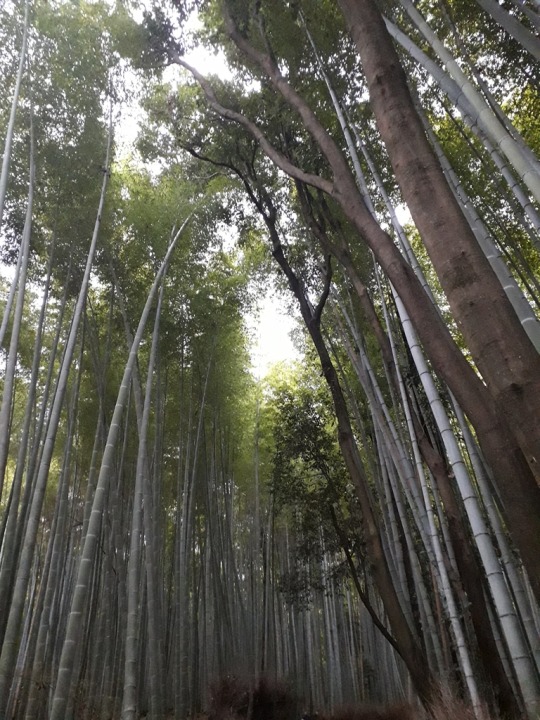
On the way back to the train, we happened to pass by a Shinto shrine in the middle of the bamboo forest, Nonomiya jinja, beautiful in its simplicity. Imperial princesses came here to purify themselves for at least a year before going to the Ise Shrine to ervve there on behalf of the emperor. Even if the custom ended in the 14th century, Nonomiya shrine still enjoys the favor of the imperial family.
In the evening we strolled a bit through the picturesque Gion district at night, had dinner, and went to bed for the next early rising.
17.12.
We got up at six sharp to go to the world-famous Fushimi Inari-taisha, the “shrine of the thousand torii” (ritual gates). We missed the train we wanted to take, lost in the mega-station, but we still arrived in time to start well before the hordes of visitors arrived. Even before entering, I witnessed something that gave a hint of how special this place is: while we were have breakfast in front of the konbini opposite the main entrance, a taxi stopped, the driver got out, prayed facing the temple right there on the tarmac, and continued his route.

The shrine was founded in the 8th century, dedicated, like the mountain where it sits, to Inari, the Shinto deity of rice, agriculture, and business, whose messenger animal is the fox. Therefore, fox-shaped statuettes are omnipresent on the altars spread all about the mountain. We went in, toured the different halls, and started the climb up Mount Inari along the torii-lined path. These gates are erected as votive offerings; the large ones, like the ones along the path, can cost as much as a luxury car, so they usually come from companies, but many minor shrines hold small, smaller, tiny, keychain-sized torii gates. Throughout the mountain, there are literally thousands of shrines: new and old, luxurious or very humble, alone or in groups, next to the path or hidden in the forest, pristine or claimed by nature.


Regardless of each person’s beliefs, Fushimi Inari has more than earned its sacred mountain status. Its atmosphere is tremendously spiritual. Even as I write this I get emotional, as I recall the overwhelming feeling that gripped me most of the way, despite the growing number of people appearing as the day progressed.
After leaving the shrine, we ate some takoyaki on the go and went to the center, to Nishiki Market, a covered street with very nice shops, especially food ones. I stopped at one which had all kinds of beautiful things, had my loot, and when I got to the cash point, the old lady took all her time to perfectly wrap the humble set of Hina dolls that I had bought. Position, bag, box, bag… I legit felt like Alan Rickman in Love Actually when Mr. Bean wraps the gift for his lover. Three times I told her she didn’t need to peel the price tags, as everything was for myself. Forget it, the price tag must go. We ate some more takoyaki to complete lunch at a place that only sells that. The basic ones were ¥280 (€1.90) for 6. In Europe, they charge you €5 for 4 balls. After eating, we went to Ginkaku-ji, the Silver Pavilion, with beautiful gardens and not as crowded as the golden one (spoiler: it's not covered in silver. That was the idea, but it never materialized).
We went down a little street that borders a canal called "The Philosopher's Path". A very bucolic and pleasant stroll, with a lot of green, traditional houses and hardly any shops, just art galleries or craft workshops. The last temple of the day was Eikan-do. Larger than we anticipated, it’s set within lush gardens and is beautiful: its many pavillions include a pagoda and a curved staircase nicknamed "sleeping dragon." Next to these stairs stands the three-needle pine, whose needles grow in groups of three, not two. It’s said to symbolize the virtues of wisdom, mercy, and sincerity. And that if you get a pine needle like that, you will be blessed with all three. Unfortunately, with everything being so clean, there was none within my reach.

⬆️ I haven't talked much about shopping so far, because the truth is there was hardly any AoT merchandise anywhere. These on the picture above are the only items they had at the Kyoto Animate store: One (1) chibi Levi clearfile; random manga volumes; One (1) Ereh acrylic stand and One (1) Levi one but it was teen Levi, not looking hot; and a "surprise" box with some chibi stuff but I'm certainly NOT spending 880¥ in a surprise. That's it. Neither Donki nor the discount place opposite had jackshit.
We had dinner on the 11th floor of the train station. Kyoto Station's building is a monster of engineering; the north hall rises ten floors above street level and includes a monumental staircase with LED colors on the risers that play with lights and even reproduce entire videos in full color (we saw the trailer for the latest Disney movie); on that side, there’s a huge department store, of which the last two floors are food courts: the 10th floor is only ramen restaurants, and the 11th floor has a bit of everything. We had beef tongue, a favourite of mine. After dinner, we went to the Sky Gallery, a walkway emerging from the 10th floor, with panoramic views of the station and the city.
18.12.
We woke up early and had breakfast at the hotel buffet, supposedly "western style," which turned out to be a hit-and-miss, not so much because of the Japanese version of what you can find at a buffet in Europe or the US, but because many of those dishes were cold, when they’re eaten warm in the West.
We started the day at Kiyomizu-dera, very spacious, with a clarity inside the temple that I hadn't seen in other Buddhist shrines. The impressive views over the city from its balcony supported by a structure of 13-meter-high wooden pillars are noteworthy. We walked down, looking at shops in Gion (there was a Ghibli shop here too!) and then we looked for an early lunch, as we had booked a kimono tea ceremony at one.
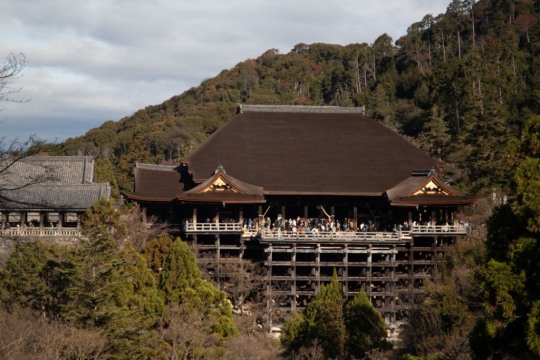
The buildig where the tea house operates is a registered cultural property. They dressed me in a kimono for me: an underrobe, tied with a ribbon (which straightens your back), the kimono itself, tied wit another ribbon, a plate to hold the obi (sash) in place, and the obi. They did my hair, and I proceeded to the salon, where Husband was already waiting for me looking like a full-fledged samurai. We were in a group of 8: us, an Australian couple about our age, and an Asian-American family of dad, mom, and two teenage children. Luckily, everyone was motivated and respectful of the place and the ritual.


After the hostess showed the entire process, she taught us how to whisk the matcha, and we enjoyed our tea (the traditional way is that everyone takes turns drinking from the same cup, but since the pandemic, each one gets their own bowl). Previously, we tasted sweets. One of them was a kind of dumpling filled with anko that blew my mind. It's called yatsuhashi and is a Kyoto specialty. The hostess wrote the name on a piece of paper for me and everything, but... My joy was short-lived, as when I went to buy it, the expiration date was quite short, so I could only got a small package to eat as soon as we returned home. Once the ceremony was over, we took photos at will in the house garden before returning the kimono.
In the afternoon we went to Nijo Castle, with impressive paintings on the door panels and exquisite marquetry on the lintels and ceilings. The historical significance of this castle is enormous, as it was the place wher the Tokugawa shogunate, better known as the Edo era, both began and ended. After the castle and more walking around the city centre, we had dinner and dragged ourselves back to the hotel, exhausted, and prepared everything to go to Nara the next day.
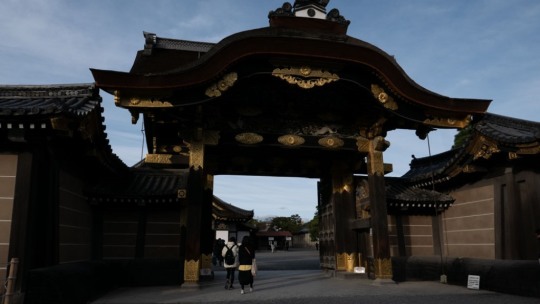
8 notes
·
View notes
Text
5 New J-Dramas on Netflix You Could Watch
Looking for new J-dramas to watch after First Love : Hatsukoi? Here are 5 J-dramas that have been released recently in 2023!
1) The Makanai : Cooking for the Maiko House

Pic by Netflix
Sumire (Natsuko Deguchi) and Kiyo (Nana Mori) are best friends from Aomori Prefecture who travels all the way to Kyoto to fulfil their dreams of becoming a Maiko, working in the Geisha district of Gion!
While Sumire has the talent and gracefulness to be one, Kiyo struggles to be one but discovers that her calling is elsewhere due to her excellent cooking skills which make the other Maiko craves for more!
It’s a relaxing slice of life drama which follows the lives of the two girls and the others they befriend and work with at the Maiko house which gives you a glimpse into their daily lives in the famous Kyoto!
youtube
2) From Me to You

Pic by Netflix
Sawako (Sara Minami) is a shy and quiet student who strikes fear in the hearts of her classmates with her gloomy outlook that resembles the ghost, Sadako, that they nicknamed her as such.
It changes when the popular student, Shota (Oji Suzuka) took notice of her and befriends her, not wanting her to be left out from the rest, which eventually caused him to fell in love with her.
It’s a healing high school romance which beautiful sceneries are enough to captivate you throughout the show which follows Sawako’s journey in making friends and have a social life like everyone else.
youtube
3) The Full Time Wife Escapist

Pic by Asian Wiki
Mikuri (Yui Aragaki) is a contract worker who struggles to find a permanent job despite having a degree. She takes on a part time job as a housekeeper where she work for the workaholic IT engineer, Hiramasa (Gen Hoshino).
Hiramasa is impressed by her work that he offered her a full time job as his housekeeper which she accepted as it’s less stressful than her office job. A series of events leads them to a contract marriage which benefit them both.
It’s a romance comedy about a fake marriage out of convenience to please their parents but their friends know something is up which leads to hilarious shenanigans on all sides as the two began to actually fall for one another.
youtube
4) Heaven and Hell : Soul Exchange

Pic by Asian Wiki
Ayako (Haruka Ayase) is a dedicated detective who stops at nothing to seek justice and ensure criminals are placed behind bars, until she goes after a cunning criminal, Haruto (Issei Takahashi) who always get away.
Haruto is an influential company director by day but a serial killer by night. Right before Ayako arrest Haruto under the full moon, their bodies are mysteriously swapped and realised the tables have turned.
It’s an intriguing crime thriller where the two tries to outwit the other while they try to get to the bottom of the mystery of how or why the switch happened, which leads back to Haruto’s secret past.
youtube
5) Invisible

Pic by Asian Wiki
Shimura (Issei Takahashi) is a ruthless detective who resorts to any methods to arrest criminals that he was demoted to a special investigation team that works on unsolved cases where he had to work with a criminal, Kiriko.
Kiriko (Ko Shibasaki), known as Invisible, is a crime coordinator of the underworld who mediates transactions for organised crime. She is like a police contact that knows the who, where, what and how of the criminal world.
Although Shimura is known to do anything to arrest criminals, working with one is the last thing he’d expect to do as a police officer and he still doesn’t trust her although she finds his methods amusing and interesting.
youtube
#the makanai: cooking for the maiko house#natsuki deguchi#deguchi natsuki#nana mori#mori nana#from me to you#kimi ni todoke#sara minami#minami sara#oji suzuka#suzuka oji#the full time wife escapist#nigeru wa haji da ga yaku ni tatsu#yui aragaki#aragaki yui#gen hoshino#hoshino gen#heaven and hell: 2 psycho people#tengoku to jigoku: psychona 2nin#haruka ayase#ayase haruka#issei takahashi#takahashi issei#invisible#inbijiburu#ko shibasaki#shibasaki ko#japanese drama#j drama#jdrama
41 notes
·
View notes